December 2024
The global home dialysis systems market size is accounted at USD 26.00 billion in 2025 and is forecasted to hit around USD 62.24 billion by 2034, representing a CAGR of 10.21% from 2025 to 2034. The North America market size was estimated at USD 9.66 billion in 2024 and is expanding at a CAGR of 10.20% during the forecast period. The market sizing and forecasts are revenue-based (USD Million/Billion), with 2024 as the base year.
The global home dialysis systems market size was calculated at USD 23.55 billion in 2024 and is predicted to increase from USD 26.00 billion in 2025 to approximately USD 62.24 billion by 2034, expanding at a CAGR of 10.21% from 2025 to 2034. The rising demand for personalized healthcare treatment is driving the growth of the market.
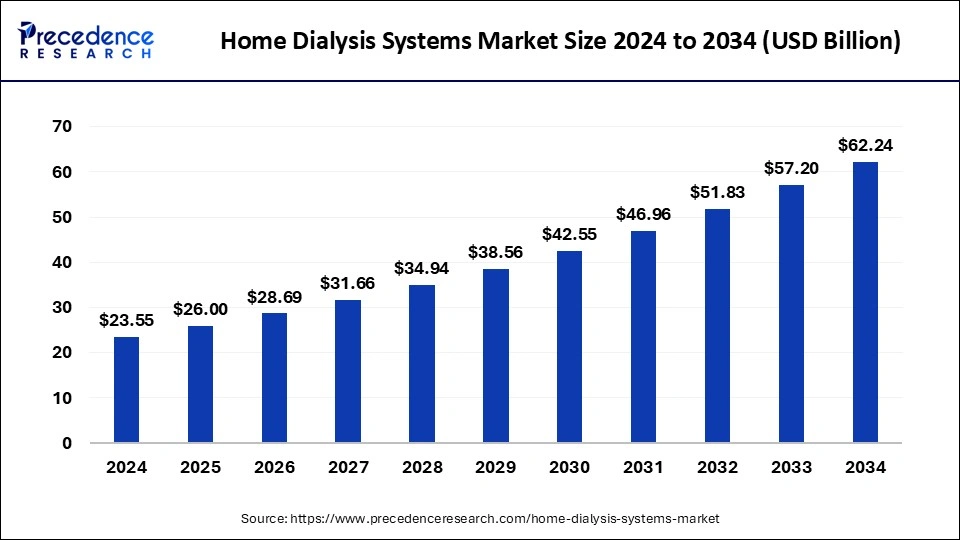
The U.S. home dialysis systems market size was exhibited at USD 6.76 billion in 2024 and is projected to be worth around USD 18.29 billion by 2034, growing at a CAGR of 10.47% from 2025 to 2034.
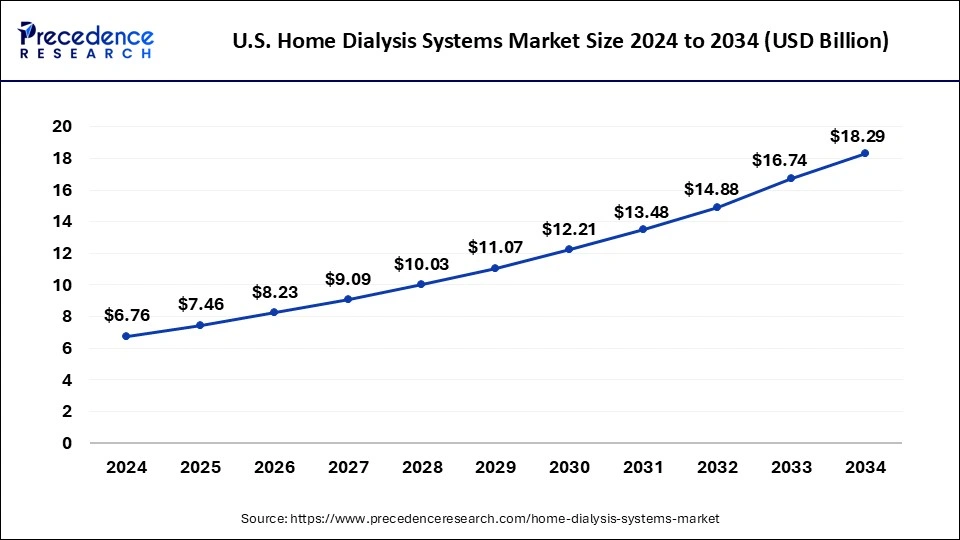
North America dominated the home dialysis systems market in 2024. The growth of the market in the region is attributed to the rising healthcare infrastructure and the increasing number of chronic illnesses in the population due to the rising geriatric population, which is driving the demand for the home dialysis market. The surging expenditure on personal healthcare due to the increasing awareness for well-being and rising disposable income in the population is driving the demand for personalized treatment, which is driving the growth of the home dialysis market system market.
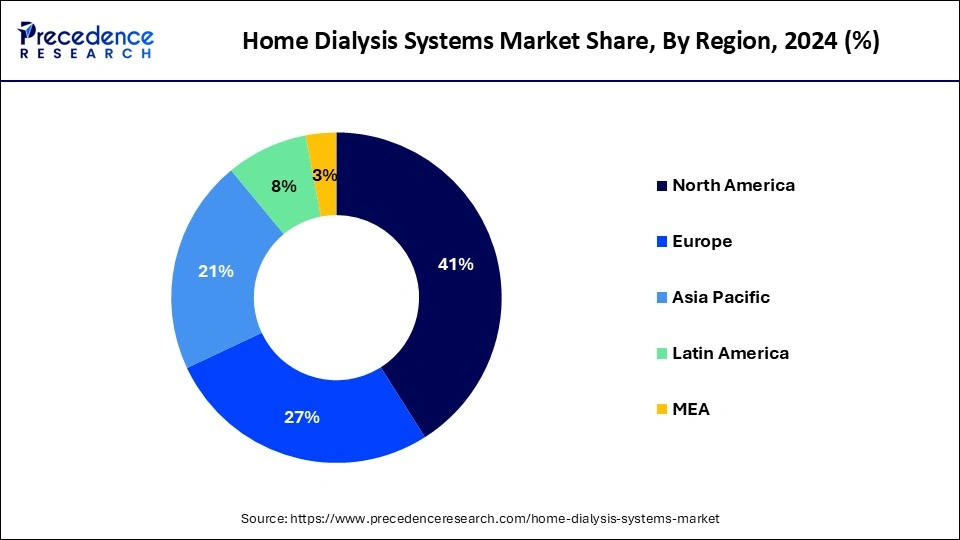
Asia Pacific is expected to increase its growth in the home dialysis systems market during the forecast period. The growth of the market is attributed to the rising population and the increasing number of geriatric patients, who are more likely to be affected by any type of kidney disease due to the aging factor, high blood pressure, and diabetes. The rising technological adoption in healthcare, such as telehealth, is also contributing to the expansion of the home dialysis system market.
Dialysis is the treatment for people with chronic kidney diseases such as kidney failure. It used to work the same as the healthy kidney; it removes the waste products and access fluid from the blood. The increasing prevalence of chronic kidney diseases such as end-stage renal diseases due to changing lifestyle preferences like low physical activity, rising consumption of alcohol and smoking, and aging factors that infect or damage the function of the kidney and lead to kidney diseases. There are five stages in kidney disease, and 5th stage is considered kidney failure. For that stage, patient doctors recommend the dialysis process for the treatment of the disease. The rising technological advancements and the demand for home comfort and personalized care at the time of dialysis are contributing to the growth of the home dialysis system market.
| Report Coverage | Details |
| Market Size by 2034 | USD 62.24 Billion |
| Market Size in 2025 | USD 26.00 Billion |
| Market Size in 2024 | USD 23.55 Billion |
| Market Growth Rate from 2025 to 2034 | CAGR of 10.21% |
| Largest Market | North America |
| Base Year | 2024 |
| Forecast Period | 2025 to 2034 |
| Segments Covered | Type, Product, Treatment, and Regions |
| Regions Covered | North America, Europe, Asia-Pacific, Latin America, and Middle East & Africa |
Increasing demand for home dialysis
Home dialysis is the revolution in renal treatment. Most of the patients that are suffering from any type of kidney disease are preferably choose the home dialysis systems for the treatment. There are several benefits of home dialysis; the use of at-home hemodialysis allows the patients to perform dialysis in the home comfort. The hemodialysis machine gives the same treatment for the purification of blood and removes the waste from the blood. Home dialysis provides the freedom to schedule the treatment, and it provides flexible management of the treatment.
The dialysis procedures are physically, mentally, and financially taxing, which results in the patient’s emotional drainage and restriction in life. Home dialysis gives better outcomes from the treatment than dialysis centers; patients experience lower complications such as fluid imbalance and infections. Home dialysis offers a more affordable long-term treatment plan by saving transportation costs and outdoor associated expenses. Thus, the adoption of home dialysis systems in the market is rising.
High cost
The high cost of investment in the home dialysis installation and other operational costs associated with the home dialysis systems are hindering the growth of the home dialysis systems market.
Technological advancements in dialysis procedures
The increasing prevalence of chronic kidney diseases in the population is driving the demand for innovations in treatment for better health outcomes and the treatment process. The integration of smart technologies, such as wearable devices and portable dialysis machines, and the major advancements in the treatment is the adoption of artificial intelligence in the dialysis process. Artificial intelligence helps in enhancing the overall treatment by developing a personalized treatment for the patients, helps in continuous diagnosis and monitoring of the patients, and helps in making informed decisions regarding their health.
There are several advancements in hemodialysis machines, such as a smart valve developed by the smart device hemodialysis Ubiplug, a France-based startup that aims to give treatment to patients with end-stage renal disease. Wearable vein dilation is the first device designed to make the vein bigger to hold the dialysis catheter. Venostent, a custom-fit vascular wrap stent, was developed to enhance dialysis patient outcomes. Moreover, the ongoing investment in research and development activities in the innovation and expansion of dialysis treatment in the in-center and home dialysis systems is driving opportunities for the growth of the home dialysis systems market.
The hemodialysis segment led the home dialysis systems market in 2024. The growth of the segment is attributed to the rising adoption of the hemodialysis procedure in dialysis treatment. In these processes, the dialysis machine and the specialized filter known as the dialyzer, or the artificial kidney, are used to clean blood. The hemodialysis is done via the small surgical process that is usually done on the arm of the patient. Patients with several kidney diseases also prefer the home hemodialysis procedure with home comfort. In-home care, patients can be better positioned for treatment. There are three different types of home hemodialysis: conventional home hemodialysis, short daily home hemodialysis, and nocturnal home hemodialysis.
The hemodialysis machine has two separate parts divided by a thin membrane, one part for blood and the other part for fluid washing, known as dialysate. In this process, blood proteins, cells, and other essential elements remain in the body because they are too big to pass through the membrane; the impure and waste products like urine, potassium, creatinine, and access fluid pass through the membrane and are washed away from the blood. The hemodialysis is done in the hospitals and dialysis centers three times per week for approximately 4 hours of time.
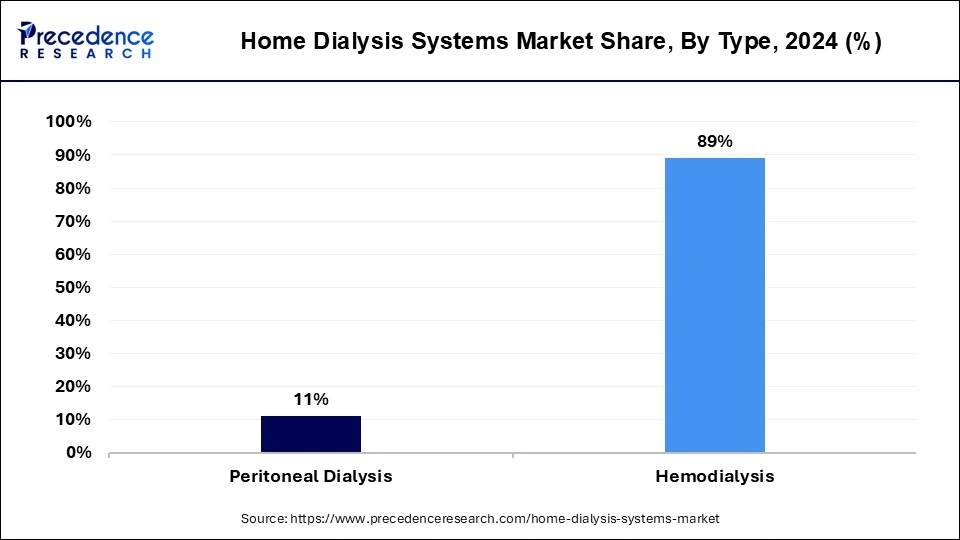
The peritoneal dialysis segment is expected to show rapid growth in the home dialysis systems market during the forecast period. Peritoneal dialysis can be performed at home, providing patients with greater flexibility and control over their treatment schedules. This convenience is a major factor driving its preference among patients who wish to maintain their daily routines and quality of life. Unlike hemodialysis, which requires frequent visits to a dialysis center, peritoneal dialysis allows patients to travel and work with minimal disruption, enhancing their overall lifestyle.
The service segment dominated the global home dialysis systems market in 2024. Services include thorough training and education for patients and their caregivers on how to use home dialysis equipment effectively and safely. This training is essential for ensuring that patients can manage their treatment independently. Regular maintenance and servicing of dialysis equipment are crucial to ensure its proper functioning and to prevent technical issues that could disrupt treatment.
The consumable segment is expected to project the largest growth in the home dialysis systems market during the forecast period. The consumables segment is further divided into bloodlines, catheters, concentrates, and other consumables. All these consumables play a significant role in home dialysis procedures. There are several advancements in the consumables, such as anti-microbial coated catheters, that help reduce infections in the bloodstream. Additionally, the ongoing research on the advancements in dialysis consumers and the rising competition among market players are driving the growth of the segment.
The chronic kidney disease segment dominated the home dialysis systems market in 2024. The increasing prevalence of chronic kidney diseases among the population due to high blood pressure, changing lifestyle preferences, and accepting harmful habits such as smoking and consumption of alcohol is causing severe damage to the kidneys. Diabetes and high blood pressure are some of the major causes of kidney failure.
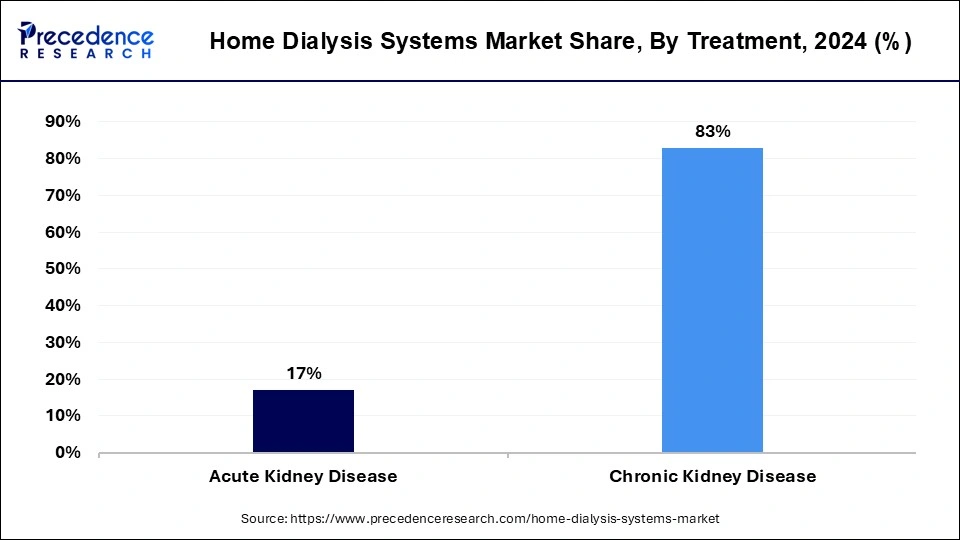
The rising geriatric population is more likely to get affected by chronic diseases like kidney diseases, which drives the demand for dialysis. The rising preference towards home dialysis procedures as compared to the dialysis center is due to the rising traffic in the healthcare center and fewer vacant beds with convenient facilities.
By Type
By Product
By Treatment
By Geography
For inquiries regarding discounts, bulk purchases, or customization requests, please contact us at sales@precedenceresearch.com
No cookie-cutter, only authentic analysis – take the 1st step to become a Precedence Research client
December 2024
August 2024
February 2025
January 2025